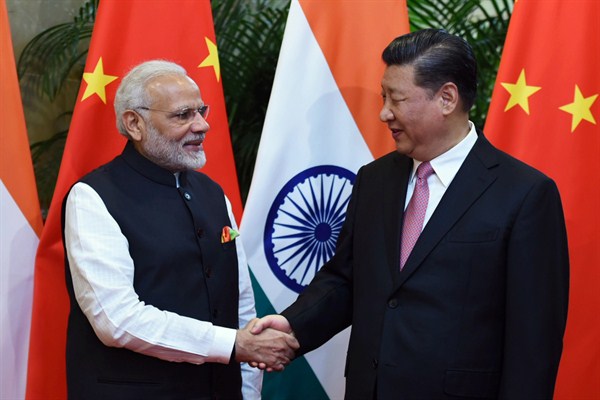The India-China rivalry may force countries in South Asia to choose sides. Find out more when you subscribe to World Politics Review (WPR).
As the India-China rivalry for influence in Asia grows, India has begun to take a bolder stance. In 2016, at Bhutan’s request, Indian forces entered the disputed Doklam territory in Bhutan to keep Chinese forces from building a road there. As the most serious conflict between India and China in decades, the standoff represented a shift in New Delhi’s posture toward Beijing, signaling India’s resolve to act more forcefully to counter Chinese influence and activities in South Asia.
New Delhi’s bold decision to confront Chinese troops at Doklam—an area near India’s so-called tri-border with China and Bhutan—surprised and angered Beijing. While India may have succeeded in standing up to China in the short run, Doklam pushed China-India tensions, problematic under the best of circumstances, into a new, tenser stage.
Any military confrontation would be devastating to both countries, but a deep and long-standing political rift would be equally unsettling given the strategic anxieties in play. Sustained, long-term hostility of any kind would be harmful for India, China and the region at large.
To learn more about the rising tensions in the India-China rivalry, read India Takes a bold Approach in Border Standoff With China, but the Endgame Is Unclear for FREE with your subscription to World Politics Review.
China Takes Rivalry With India to South Asia
The Doklam standoff followed years of Chinese encroachment into countries in India’s “backyard.” The China-India clash over regional geo-economics is now affecting Sri Lanka, Nepal and Bangladesh, which have sought more balanced relations with both India and China. At the heart of China’s regional policy is the objective of maintaining stability for its own domestic security and sustainable economic development. But India maintains the upper hand for now: In terms of foreign direct investment, in most of South Asia, India has invested significantly more than China. Both India and China will continue, however, to protect their gains and consolidate their influence as their financial and political commitments across the region grow, leading to continued tensions.
To learn more about China’s outreach to countries in South Asia, read As China Expands Its Ties in South Asia, It Faces a Familiar Rival: India for FREE with your subscription to World Politics Review.
[marketing]ofie[/marketing]
The India-China Rivalry Casts a Shadow On India’s Neighbors
Bangladesh is a good illustration of the challenges India faces in its rivalry with China. India’s relations with Bangladesh are in fairly good shape, and have improved significantly in recent years. The two countries have quietly pursued a series of energy deals that can potentially bring big benefits to both nations. Additionally, discussions have begun for an electricity-sharing mechanism between India, Bangladesh, Bhutan and Nepal. But the biggest irritant in India-Bangladesh relations is China’s deepening inroads in Bangladesh. India hasn’t been able to stop China from deepening its footprint and influence in New Delhi’s backyard, from Pakistan to Sri Lanka and many places in between, leading to worries that it’s slowly being pinned down and encircled by China.
Can India deepen ties with Bangladesh at the same time China does? To find out more, read Why India and China Are Competing for Better Ties With Bangladesh for FREE with your subscription to World Politics Review.
The Role of the India-China Rivalry in Sri Lanka’s Recent Coup Crisis
Though India-China relations have warmed since the Doklam standoff, a recent political crisis in Sri Lanka illustrates how the fallout from their rivalry continues to be felt throughout South Asia. Sri Lanka emerged from its crisis with its democracy and constitution miraculously intact. An attempted coup, in which the president violated the constitution by replacing the sitting prime minister with his bitter rival and presidential predecessor, Mahinda Rajapjaksa, was overturned thanks to Sri Lanka’s defiant Parliament, steadfast judiciary, a vigilant international community and a resilient civil society. The failed coup revealed Sri Lanka’s institutions to be sneakily strong, but as it barreled along, international and domestic watchers speculated about the nefarious role foreign actors may have played—especially India and China, which have long projected power in Colombo.
To learn more about how the India-China rivalry contributed to Sri Lanka’s recent political crisis, read Were Local Politics or Geopolitical Rivalries Behind Sri Lanka’s Recent Coup Crisis? for FREE with your subscription to World Politics Review.
[marketing]ofie[/marketing]
Learn more about the geo-economic maneuvering in the India-China rivalry and a wide variety of other issues affecting South Asia in the vast, searchable library of World Politics Review (WPR):
- Recent tensions between Asia’s two powers, in India Takes a Bold Approach in Border Standoff With China, but the Endgame Is Unclear
- China’s inroads into South Asia, in As China Expands Its ties in South Asia, It Faces a Familiar Rival: India
- How Bangladesh factors into the China-India rivalry, in Why India and China Are Competing for Better Ties With Bangladesh
- How diplomacy is tempering the India-China rivalry, in Why Modi and Xi made Nice at Asia’s Other Landmark Summit
- How the India-China rivalry played a role in Sri Lanka’s recent political crisis, in Were Local Politics or Geopolitical Rivalries Behind Sri Lanka’s Recent Coup Crisis?
[marketing]boilerplate[/marketing]
Editor’s Note: This article was first published in August 2018 and is regularly updated.

